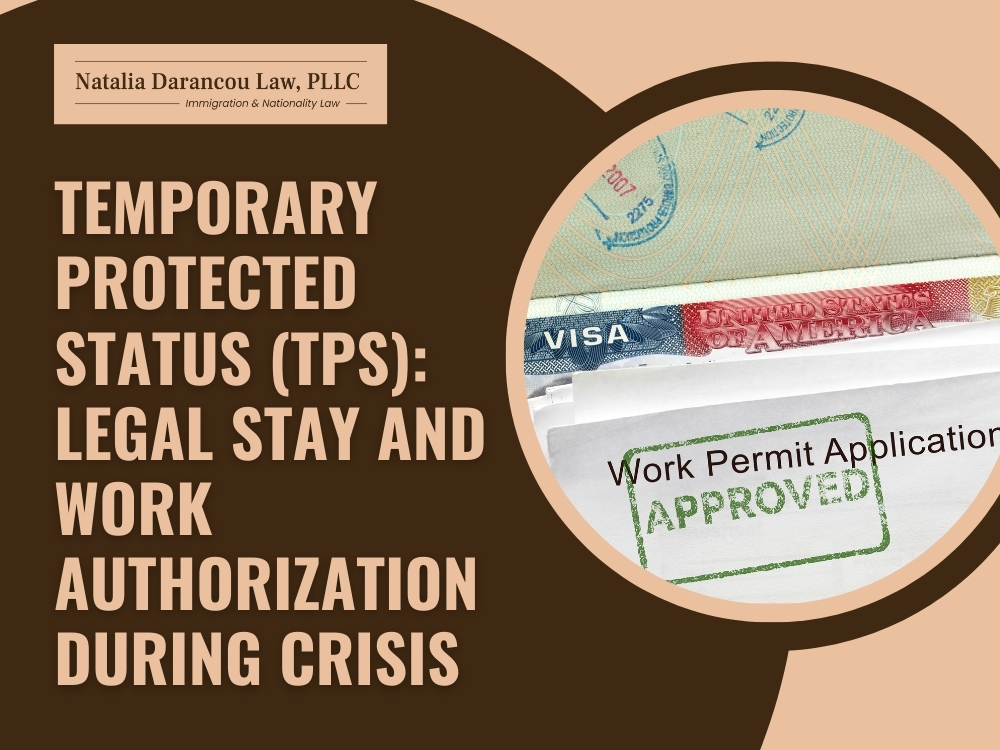Temporary Protected Status
Guide to Form I-821
The U.S. government created the Temporary Protected Status (TPS) program to offer legal status and stability to foreign nationals during crises or upheaval in their home countries.
However, TPS is not a permanent immigration status, which raises an important question for many beneficiaries: Is there a pathway from TPS to green card status?
This guide will explain what TPS is, how to apply, and the possible avenues for adjusting status to obtain lawful permanent residency.
Table of Contents

Request A Consultation Today!
Request Help Today
Get the Immigration Assistance You Deserve And
Schedule Your Consultation Today!

4.9 Google Rating
We have a 4.9 Star Rating with over 30 reviews on Google!

Woman Owned
We are a woman-owned company and proudly committed.

Native Spanish Speaker
Natalia Darancou was born and raised in El Paso, Texas to Mexican-American parents and is a native Spanish speaker.

Memberships
Member of the New York State Bar, Texas State Bar, and a member of the American Immigration Lawyers Association (AILA).
What is TPS?
Temporary Protected Status (TPS) is a temporary immigration benefit granted by the United States government to eligible nationals of certain countries facing extreme conditions or extraordinary situations.
The Secretary for the Department of Homeland Security has the authority to grant TPS to a country based on conditions such as:
- Armed conflict such as enemy invasion, civil war, and genocide
- Environmental disasters like earthquakes, hurricanes, famine, or epidemics
- Other extraordinary and temporary conditions that make it unsafe for nationals to return

The designation lasts for 6 to 18 months but can be extended by the U.S. government depending on the conditions in the country.
Under TPS, beneficiaries can legally remain in the U.S. without fear of removal, obtain work authorization, and apply for travel authorization. However, there is no automatic path from TPS to green card status or U.S. citizenship. Beneficiaries must explore other pathways to adjust their status.
Form I-821 Application Process
The TPS program is always subject to change. The USCIS website provides information on the current rules for those who have or are applying for TPS status.
1. Determine Eligibility:
- You must be a national of a designated TPS country.
- You must have been continuously present in the U.S. since the designation date.
- You must meet all TPS requirements, including criminal and security checks.
2. File Form I-821:
- To apply for TPS, you must submit Form I-821, Application for Temporary Protected Status, to U.S. Citizenship and Immigration Services (USCIS).
- Fill it out with accurate information and submit the required documents, such as proof of nationality, proof of U.S. residence, and supporting affidavits if necessary.
- Use this form for both initial applications and re-registration of your status.
3. Apply for a Work Permit (optional)
- If you want to work, you must submit Form I-765 (Application for Employment Authorization) with your Form I-821.
4. Biometrics Appointment:
- USCIS requires applicants to attend a biometrics appointment to provide fingerprints, photos, and a background check.
5. Await USCIS Decision:
- If approved, you will receive temporary protection from deportation and, if requested, an Employment Authorization Document (EAD).
- If denied, your lawyer can help you file an appeal or motion to reopen the case, depending on the reason for denial.
You are granted TPS status for 6 to 18 months, and you can renew it if the country’s designation remains in effect.
Don't Risk Your Future By Taking On The Process Alone!
How to Adjust from TPS to Green Card Status
Most people hope to transition from TPS to a green card. Several pathways exist for eligible individuals.
Family-Based Green Card
TPS holders with a U.S. citizen spouse, parent, or child 21 years or older may be eligible to adjust from TPS to green card status through family sponsorship. A status adjustment can only be done if you entered the U.S. legally, otherwise, you may need to apply for a waiver or go through consular processing, depending on your situation.

Employment-Based Green Card
Some TPS holders may qualify for a green card through employment sponsorship. If an employer is willing to sponsor you, you may apply for a green card under EB-2 or EB-3 employment categories.
Asylum or Refugee Status
If a TPS holder fears persecution in their home country due to their race, religion, nationality, political opinion, or membership in a particular social group, they may be eligible to apply for asylum. If granted, you can apply for a TPS to green card adjustment one year later. Not all TPS holders qualify for asylum, as they must prove a well-founded fear of persecution.
Special Adjustment Programs
From time to time, Congress passes special laws that provide pathways to permanent residency for certain TPS holders. One example is the Liberian Refugee Immigration Fairness (LRIF) Act, which allowed eligible Liberians with TPS to apply for green cards. Check the USCIS website for the complete list of programs to get a green card through other categories.
Do You Need an Immigration Lawyer?
TPS provides essential protection for individuals from crisis-stricken nations, but it is not a permanent solution. While TPS does not automatically lead to a green card, pathways exist for some beneficiaries to adjust their status from TPS to a green card through family sponsorship, employment, asylum, or legislative relief.
The TPS to green card process is complex. It is highly recommended that TPS holders consult with an attorney to explore their best legal options. Schedule a consultation with Natalia Darancou Law and start filing your form I-821 today!

